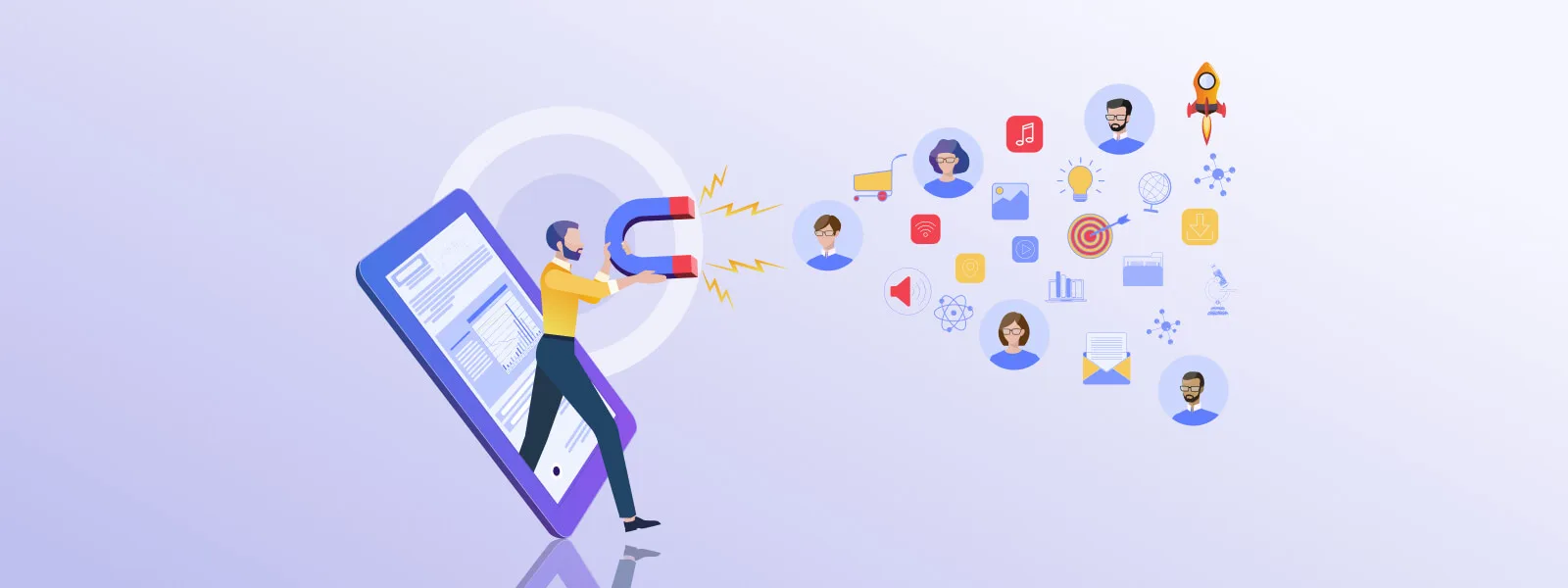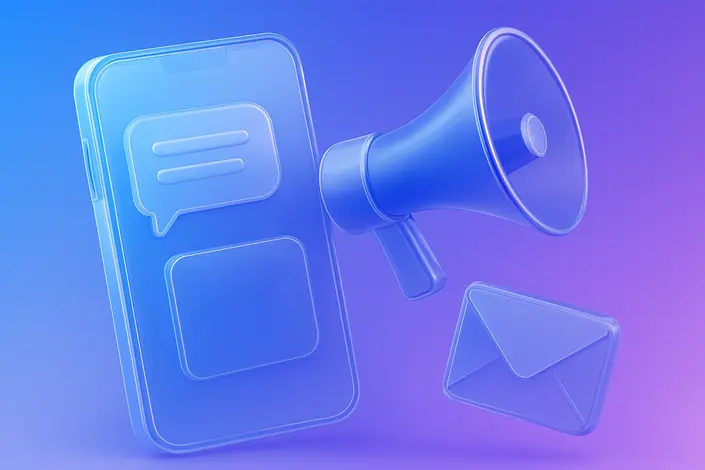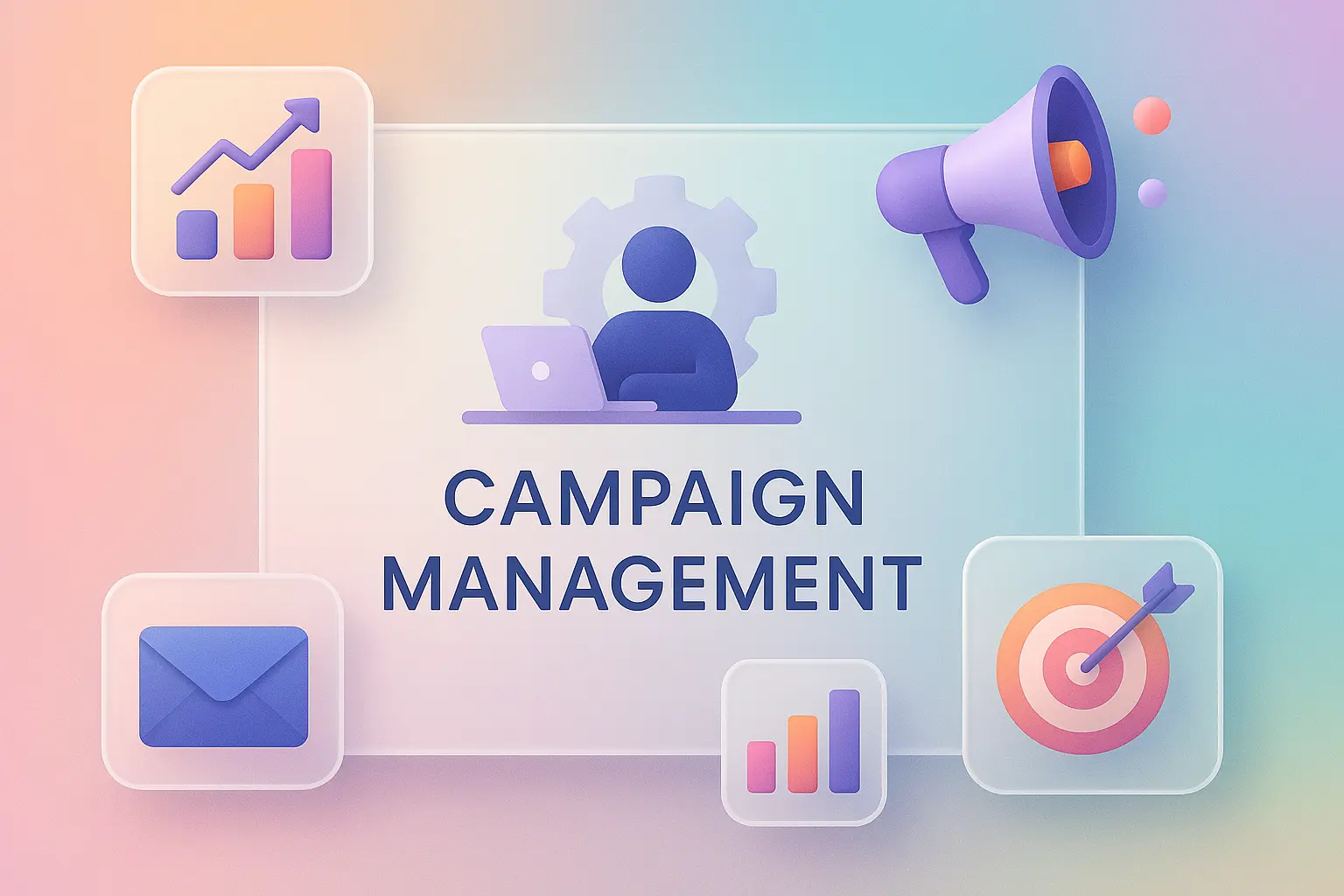What is Multichannel Marketing? Benefits, Strategies, and Examples
- March 7, 2024
- 18 mins read
- Listen

What is Multichannel Marketing?
Multi-channel marketing is a strategy of using multiple channels to engage with customers. It’s an approach to leveraging a combination of offline and online platforms to reach customers and enlarge the business presence.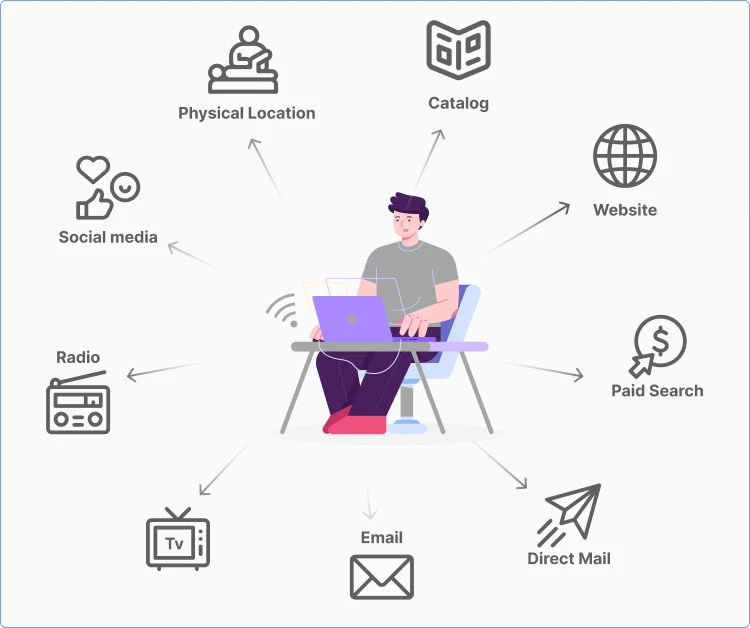 One of the purposes of using multichannel marketing is to connect with the target audience at various touchpoints and ensure consistent value to them throughout their customer journey. The goal of this kind of marketing is to meet customers where they are and engage with them across their preferred channels. Adopting a multichannel marketing strategy gives the flexibility to integrate messaging, branding, and experiences seamlessly across all channels. It’s also essential for delivering tailored experiences specific to individual customer’s behaviors and preferences.
One of the purposes of using multichannel marketing is to connect with the target audience at various touchpoints and ensure consistent value to them throughout their customer journey. The goal of this kind of marketing is to meet customers where they are and engage with them across their preferred channels. Adopting a multichannel marketing strategy gives the flexibility to integrate messaging, branding, and experiences seamlessly across all channels. It’s also essential for delivering tailored experiences specific to individual customer’s behaviors and preferences. Omnichannel Marketing vs. Multichannel Marketing
Omnichannel marketing and multichannel marketing are two approaches to engaging with customers across various channels. Both involve multiple channels but the focus area of each approach is very different. Omnichannel marketing programs integrate various channels and touchpoints, providing a friction-free customer experience. When this approach is used, all the platforms work together and customers can move between channels easily.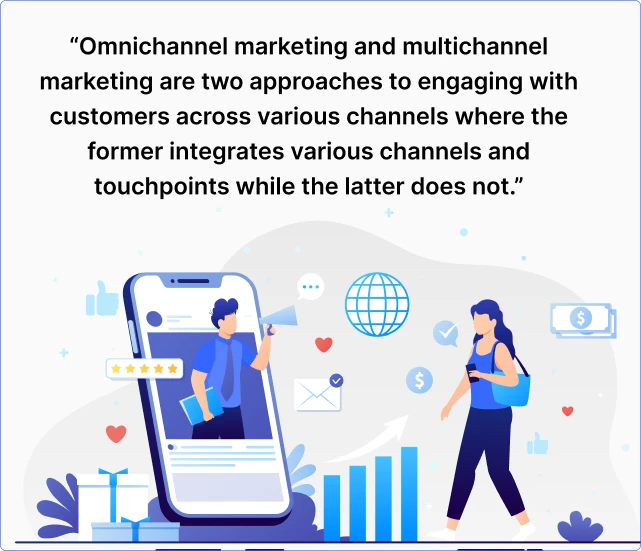 Multichannel marketing also involves promotion on various platforms but it has less focus on integrating those channels for the customer. Each channel will operate independently which may result in disjointed customer journeys. Between the two approaches, omnichannel marketing emphasizes seamless and integrated experiences across all channels. It also recognizes the value of meeting customer needs regardless of the choice of channels they choose.
Multichannel marketing also involves promotion on various platforms but it has less focus on integrating those channels for the customer. Each channel will operate independently which may result in disjointed customer journeys. Between the two approaches, omnichannel marketing emphasizes seamless and integrated experiences across all channels. It also recognizes the value of meeting customer needs regardless of the choice of channels they choose. When to Use Omnichannel vs. Multichannel
The decision to use omnichannel or multichannel marketing depends on the specific goals of the business. It also relies on the resources and capabilities of the business. Both strategies have their unique advantages and can complement a business’s overall marketing objectives.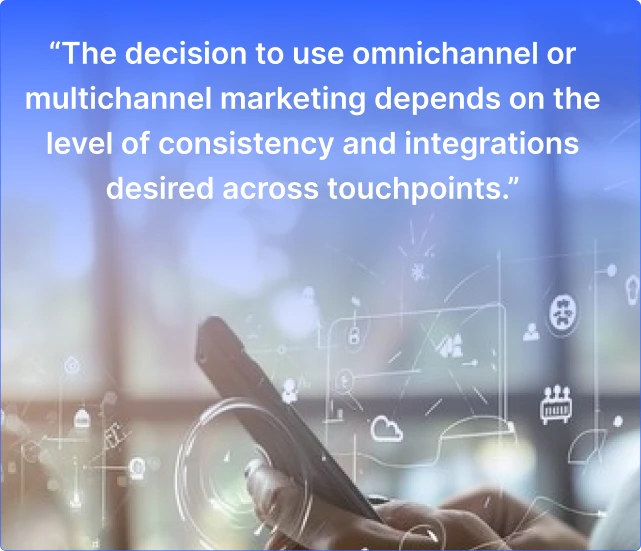
When to Use Omnichannel
- When your goal is to offer seamless and personalized experiences to your customers across all channels
- When you aim to maintain consistency and continuity in branding and messaging throughout the customer journey
- When you look to deliver a cohesive brand experience across all touchpoints
When to Use Multichannel
- When you want to reach a broad audience across different channels
- When you aim to leverage multiple channels without the need for integration between them
- When your marketing strategy is channel-specific
Channels Used in Multichannel Marketing
Multichannel marketing involves the use of various channels to reach and engage with the audience. These channels fall under different categories with unique features and focus points. The choice to use the channel, and category of channels, will depend on the goal of the business.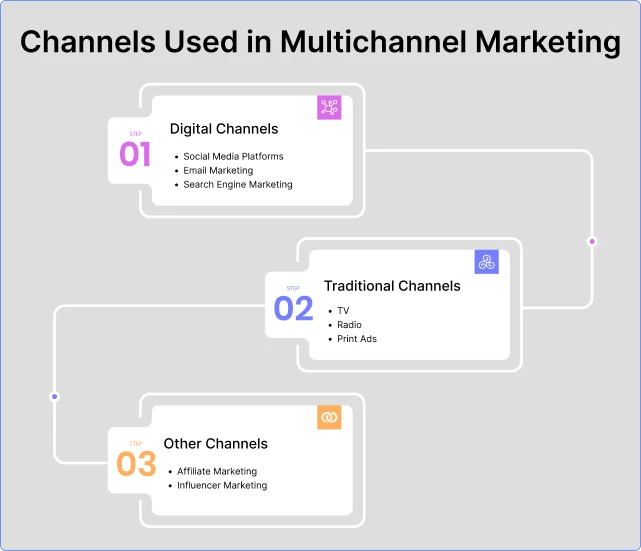 Let’s look at all the three broad categories of channels used in multichannel marketing –
Let’s look at all the three broad categories of channels used in multichannel marketing – 1. Digital Channels
- Social Media Platforms ( Facebook, Instagram, Twitter, LinkedIn )
- Email Marketing ( Newsletters, Drip Campaigns)
- Search Engine Marketing ( SEO, PPC & Display Ads)
- Content Marketing (Blogs, Articles, Videos, )
- Website and Landing Pages
- Mobile Marketing (Apps, SMS, Push Notifications)
- Chatbots and Messaging Apps
2. Traditional Channels
- TV
- Radio
- Print Ads
- Outdoor Ads
- Telemarketing
3. Other Channels
- Affiliate Marketing
- Influencer Marketing
- Customer Service Channels (Live Chat)
Benefits of Multichannel Marketing
Multichannel marketing is the best strategy for businesses seeking to maximize their reach. It enables better engagement and conversion opportunities. More so, today 73% of retail consumers use multiple channels to buy products and services of their choice.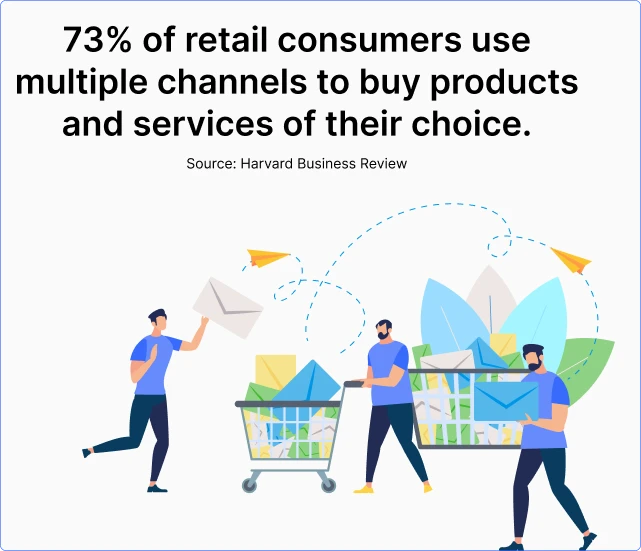 Here are the key multichannel marketing benefits –
Here are the key multichannel marketing benefits – - Broader Audience Reach – A business that utilizes multiple channels can expand its reach and connect with a broader audience. With various platforms and devices for help, it becomes easy to increase brand visibility and reach different segments of the audience.
- Higher Levels of Engagement – Using a variety of channels for interaction can help a business offer more personalized and relevant experiences. It can engage with customers at different touchpoints and ensure value at each stage of their journey. All this can lead to higher levels of engagement.
- Meeting Customers Where They Are – Customers feel happy and satisfied when businesses offer multiple channels for communication and interaction. Adopting this approach is essential for meeting customers where they are and increasing their level of satisfaction with the business.
- Increased Chances of Conversion – A business can gather more data when it has various channels for customer engagement. This can prove helpful in devising a data-driven approach to understanding the audience’s needs. Based on that, offering them tailored messages becomes easy. Chances of conversion go up when data-backed insights are available.
- Optimized ROI – Having multiple channels is essential when a business wants to diversify its marketing efforts. This strategy also helps in allocating resources effectively and based on the way each channel performs, resulting in an optimized return on investment (ROI).
- More Leads and Sales – The strategy of multiple channels opens up more chances for engagement through consistent messaging and offering at each touchpoint. The business gets more customers to guide through the buying process, resulting in more leads and sales over time.
Multi-Channel Marketing Challenges
Multichannel marketing is a rewarding strategy as over 50% of marketers believe that it delivers excellent ROI. It however also requires a careful consideration of different aspects. With multiple channels involved, there are certainly more chances of errors which can impact customer experiences.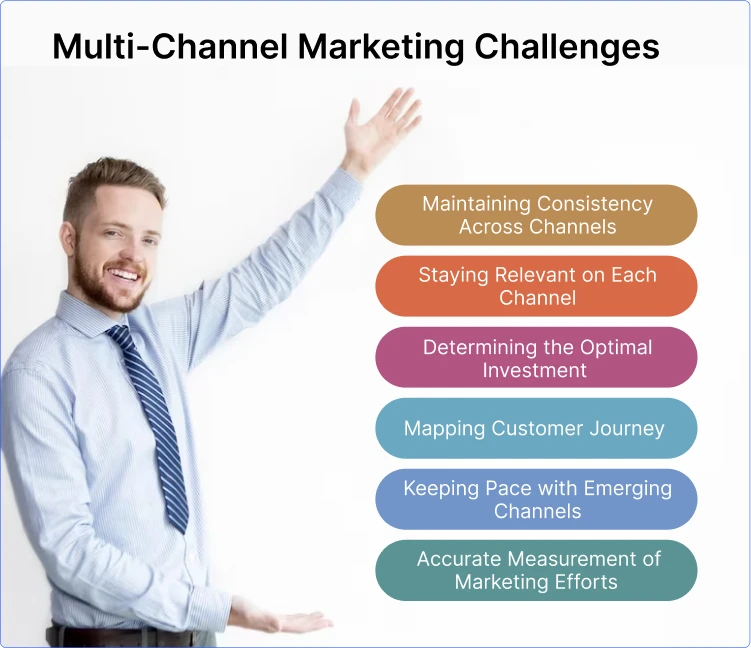 Let’s look at some major challenges that are involved with a multichannel marketing approach –
Let’s look at some major challenges that are involved with a multichannel marketing approach – - Maintaining Consistency Across Channels – Customer experience is often compromised when there is a lack of consistency in the tone, style, and presentation of messages across channels. For any business that leverages multiple channels, keeping everything consistent across all channels will always be a big challenge.
- Staying Relevant on Each Channel – There are so many marketing channels and it requires considerable efforts and resources to stay relevant on them all. Lack of budget or poor planning may make gaining customer attention across channels extremely hard.
- Determining the Optimal Investment – Judicious resource allocation can be complex when there are many channels to cater to. Without proper planning and analysis, a business may find it difficult to determine the optimal mix of investments for each channel.
- Mapping Customer Journey – A business has to work less to map customer journeys and understand interactions when the number of channels is fewer. However, customer journey optimization becomes incredibly complex when there are multiple channels involved.
- Keeping Pace with Emerging Channels – Adapting to emerging trends and channels is easier said than done as it requires a strategic approach across all levels. If a business is not monitoring new channels and tech evolution, it might fail to challenge other players in the industry.
- Accurate Measurement of Marketing Efforts – It takes advanced analytics to accurately measure the impact of marketing efforts across all channels. Not having adequate resources, tools, and support can be a big detriment in knowing which channel contributes most and which the least.
Key Components of a Multi-Channel Marketing System
A multi-channel marketing system is an effective approach to reaching customers across all touchpoints and engaging better. It is critical to forge stronger relationships with customers who want businesses to meet on the channel of choice.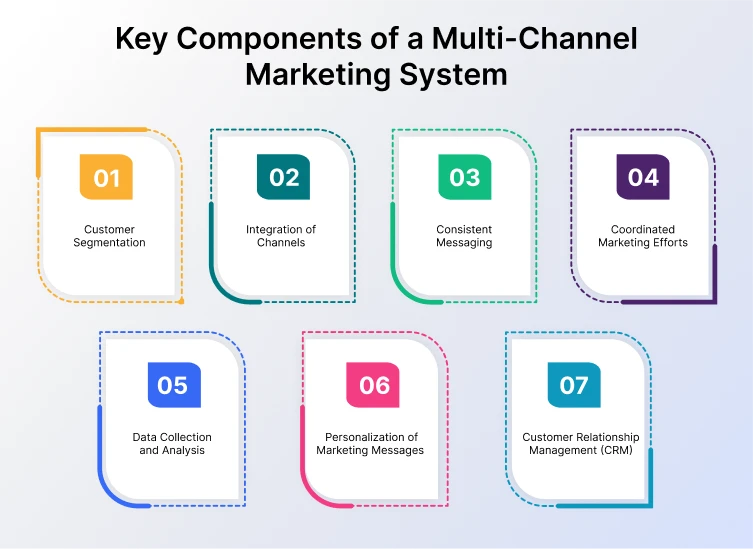 Here are the key elements of a multi-channel marketing system –
Here are the key elements of a multi-channel marketing system – - Customer Segmentation – A business can deliver personalized messaging effectively and target customers across channels only when it has segmentation in place.
- Integration of Channels – A robust multi channel marketing system is achieved only when there is a seamless integration of various channels.
- Consistent Messaging – Maintaining consistency in messaging across all channels is essential to ensure a unified brand identity.
- Coordinated Marketing Efforts – An effective cross-channel marketing system is established only when there is a coordinated marketing effort.
- Data Collection and Analysis – Gathering and analyzing data from various channels is essential for a successful cross-channel system.
- Personalization of Marketing Messages – Customer insights are vital to personalize offers based on unique demographics and behavior.
- Customer Relationship Management (CRM) – A business must implement a CRM system to effectively manage customer data and interactions across channels.
How to Create an Effective Multi-Channel Marketing Campaign?
A business needs an effective multi-channel marketing campaign to reach and engage its audience across multiple channels. It however takes careful planning, execution, and optimization across various channels to make the campaign successful. Data and feedback also play a vital role in refining the approach and achieving success with the multi-channel campaign. The steps to creating a successful multi-channel marketing campaign are as follows –Step 1 – Define Your Goals
Having well-defined goals is essential for implementing a successful approach to multi-channel marketing. Whether your business wants to generate leads, drive traffic, boost sales, or increase brand awareness, the goals you set will drive your strategy and metrics in the right direction.Step 2 – Conduct Research
Once you have defined your goals, the next step is to choose the relevant channels that align with your objectives. You will need to do thorough market research to understand your audience and its pain points, behaviors, and preferences.Step 3 – Analyze Each Channel
A successful multi-channel marketing strategy uses a combination of channels to cater to the target audience. The right approach is to analyze the strengths and weaknesses of each channel and see how they fit in your marketing effort.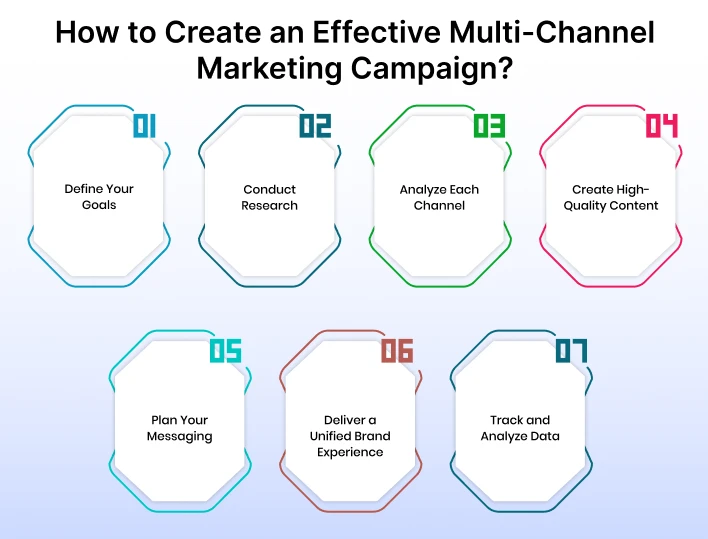
Step 4 – Create High-Quality Content
Creating high-quality content tailored to each channel is the next important step. Here, the focus should be on developing a variety of content types and pieces that align with your campaign goals. Make sure the content resonates with your audience and is optimized for impact.Step 5 – Plan Your Messaging
Your brand messaging needs to be customized for each channel and audience. This will help ensure consistency of communication and value proposition across all channels.Step 6 – Deliver a Unified Brand Experience
It’s important to develop cohesion among multiple channels to deliver a unified brand experience to your audience. For example, you can promote social media posts using email or online channels to promote real events.Step 7 – Track and Analyze Data
Now when your multi-channel marketing campaign is ready, start tracking and analyzing data from various touchpoints. You can monitor KPIs such as conversion rates, CTR, and traffic to measure how effective your campaign is.Popular Multichannel Marketing Solutions For Your Business
Businesses need feature-rich solutions to optimize their multichannel marketing efforts. Tons of popular software platforms are available to implement marketing campaigns across various channels. It is, however, important to choose a solution that is the right match for your business needs, budget, and scalability. Let’s look at some of the popular multichannel marketing solutions and tools for online businesses –1. Salesforce Marketing Cloud
Executing effective marketing campaigns across various channels is easy when you have quality solutions at hand. Salesforce Marketing Cloud is one such comprehensive multichannel marketing solution to create and manage campaigns on any scale. Its suite of tools can be effective in engaging with customers across touchpoints and driving meaningful results.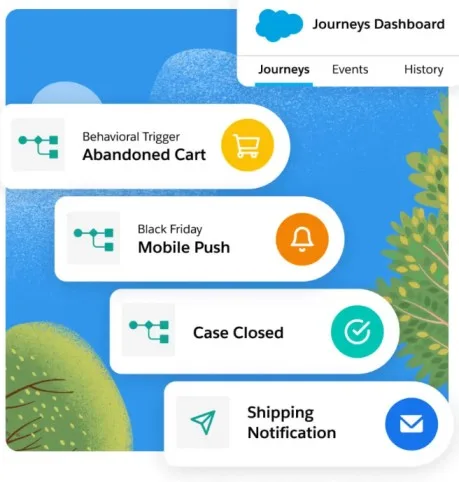
Key Features
- Tools for Email, Mobile, and Social Media Marketing
- Journey Builder & Content Management
- Analytics and Reporting
- Personalization and AI
2. Adobe Campaign
Many businesses may look for a solution that helps them deliver engaging experiences across various digital channels. Adobe Campaign can help as it’s designed to enable the automation of marketing campaigns across channels. Its comprehensive features and capabilities are essential for driving customer engagement and achieving measurable results.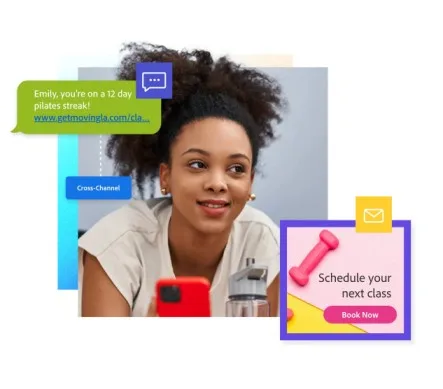
Key Features
- Tools for Multi-Channel Campaign Management
- Robust Personalization and Segmentation Capabilities
- Automation and Workflows
- Campaign Analytics and Reporting
3. Mailchimp
It’s the right tool for businesses looking to engage with their audience across email, social platforms, ads, landing pages, and more. As a comprehensive multi-channel marketing solution, Mailchimp has a wide range of features and capabilities for engaging with audiences across various platforms. The stand-out aspects of this solution are its user-friendly interface and integrated approach to marketing.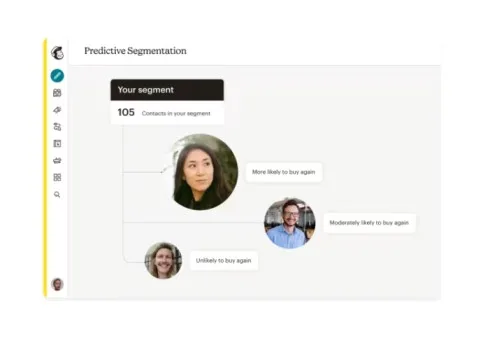
Key Features
- Email as Core Functionality with Templates
- Tools for Social Media Management
- Digital Advertising Features
- Easy Landing Pages Creation
4. Brevo ( formerly Sendinblue)
It is a popular choice for a comprehensive range of marketing tools to engage with audiences across various touchpoints. Brevo ( initially it was called Sendinblue) is a right-match solution for businesses looking to engage across email, chat, SMS, and other channels.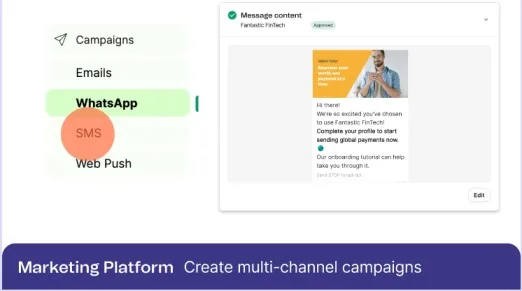
Key Features
- Robust Email Marketing Tools
- Features for Targeted SMS Campaigns
- Marketing Automation Features
- CRM Integration
Best Practices for an Effective Multichannel Marketing Strategy
Implementing a multichannel marketing strategy involves planning and careful consideration of various factors. There are best practices to follow for creating and executing a robust strategy for various marketing channels. If your business is ready to adopt a strategic approach to marketing across customer touchpoints, it will find it easy to reach and engage the audience on their channels of choice. Following are some of the best practices for a successful multi-channel marketing strategy –Understand the Buying Habits of Your Target Audience
A successful marketing strategy is always built on the foundation of complete customer understanding. When you know your audiences well, it becomes easy to serve their interests and needs. The key is to conduct detailed research to gain insights into customers’ demographics, preferences, and buying habits.Set Clear and Measurable Objectives for Your Marketing Strategy
Chances of achieving success with marketing efforts go higher when businesses have clear and measurable objectives in place. When there are clear goals in sight, your business can be guided in the right direction, resulting in sustainable growth and success over time. It’s important to have a clear analysis of each channel before launching digital marketing campaigns for them.Evaluate Whether the Channels Align with Your Business Goals
Many businesses fail to realize that not every channel will match their marketing goals. Despite that, most of them try to leverage the maximum channels they can, resulting in poor ROI on marketing efforts. The right approach is to first identify the channels that align with your target audience, and that fit with your long-term goals.Adopt a Segment-Based Personalization Strategy
Your marketing campaigns will never be ideal for all your audience segments. That’s why you need more focus on customer segmentation and data for devising a robust personalization strategy. Make sure your messages are tailored based on diverse factors such as purchase history, browsing behavior, and engagement levels of the segment.Consider Cross-Channel Marketing Automation
Cross-channel marketing automation is essential for streamlining marketing efforts and ensuring a seamless experience for customers. A business can automate a variety of marketing tasks such as campaign deployment, segmentation, and personalization to provide consistency of experience. This approach will help in delivering relevant and impactful messages to the audience.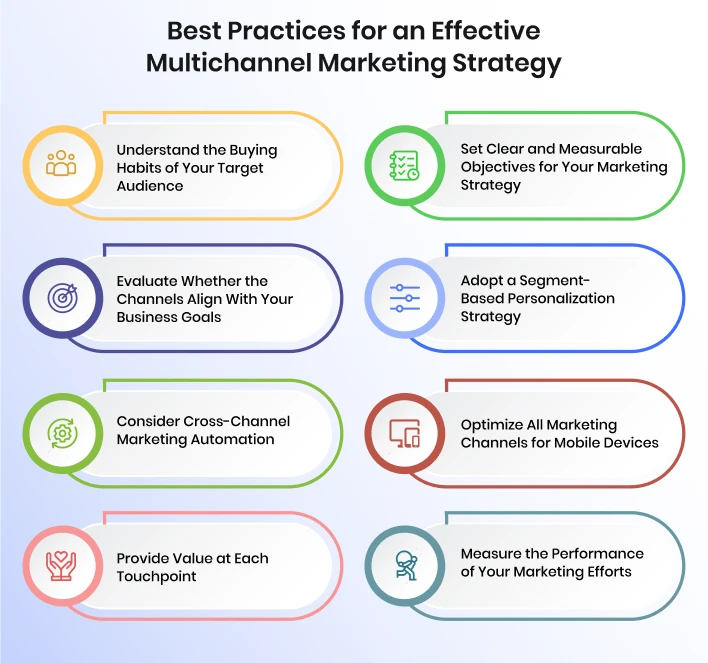
Optimize All Marketing Channels for Mobile Devices
More customers than ever before use mobile devices and smartphones to reach out to businesses for engagement and interaction purposes. Keeping this in mind, your business should take steps to optimize all channels for mobile devices. From creating responsive website design to using mobile-optimized content, there are many ways channels can be optimized for the audience on the move.Provide Value at Each Touchpoint
Marketing efforts are truly successful when the business provides value to customers at each touchpoint. The key is to make the customer journey hassle-free and smooth. This can lead to enhanced experiences at each stage of the journey. Make sure all your marketing efforts, right from quality content to excellent customer service, are aimed at building trust and loyalty.Measure the Performance of Your Marketing Efforts
What purpose would it serve when you spend so many resources on marketing and don’t regularly measure the performance? Don’t make this mistake and rather use tools for tracking and analyzing data from various touchpoints. Make sure you monitor and analyze key metrics such as engagement, traffic, and ROI to identify areas of improvement.Multichannel Marketing Examples
Many brands are setting good standards for engaging audiences across various touchpoints and ensuring value to each segment. They are using multiple channels to their advantage and growing the brand visibility and driving growth. Here are some multichannel marketing examples from across industry verticals –Example 1 – Nike’s “Just Do It” Campaign
Nike is a great example of how to leverage the power of multichannel marketing and reach the audience. Whenever they launch a new shoe, a promotional video appears on social channels. They follow it up by sending targeted email campaigns where the focus is to showcase the benefits and features of the product. Buyers can also purchase the shoes from their website or mobile apps. More so, in-store promotions are also quite common for Nike.
Example 2 – Starbucks Rewards Program
Starbucks is another brand that knows how to get the most out of multichannel marketing. Its loyalty programs are strategically integrated across multiple channels. It gives customers the freedom to sign up for the program through the website or mobile app. The company also uses email and push notifications for sending personalized offers. It leverages user preferences and purchase history for its loyalty programs.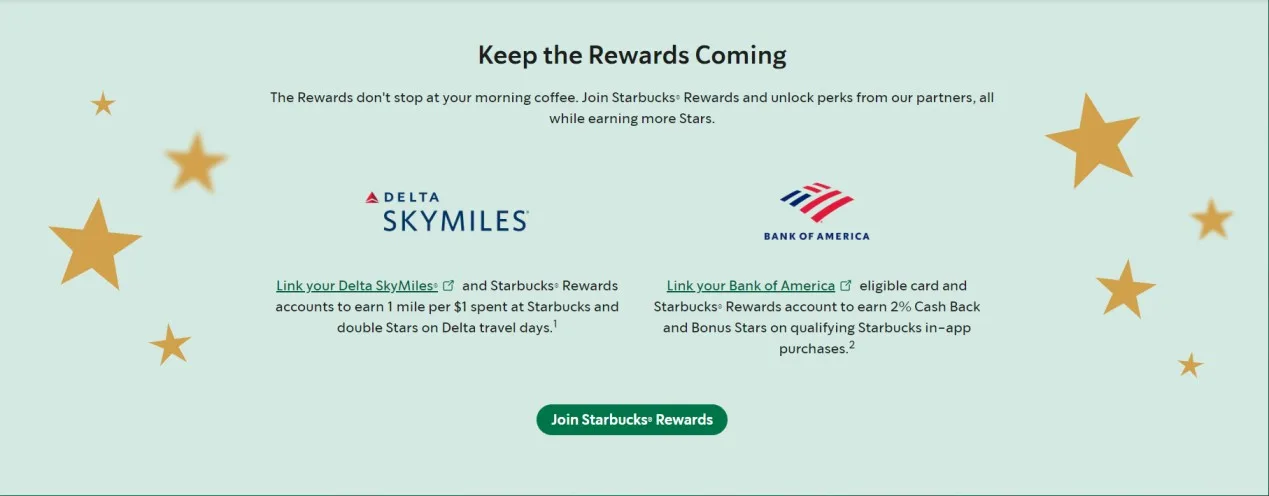
Example 3 – Amazon Prime Day
Most of us might be aware of Amazon’s annual Prime Day event and how it generates so much interest across the world. Well, the way Amazon uses multichannel marketing is the reason why this event became so successful. This event is promoted through various channels such as TV ads, social media ads, website banners, and newsletters. Once the events roll about, customers get the freedom to shop through the Amazon website, mobile apps, and also by using Alexa.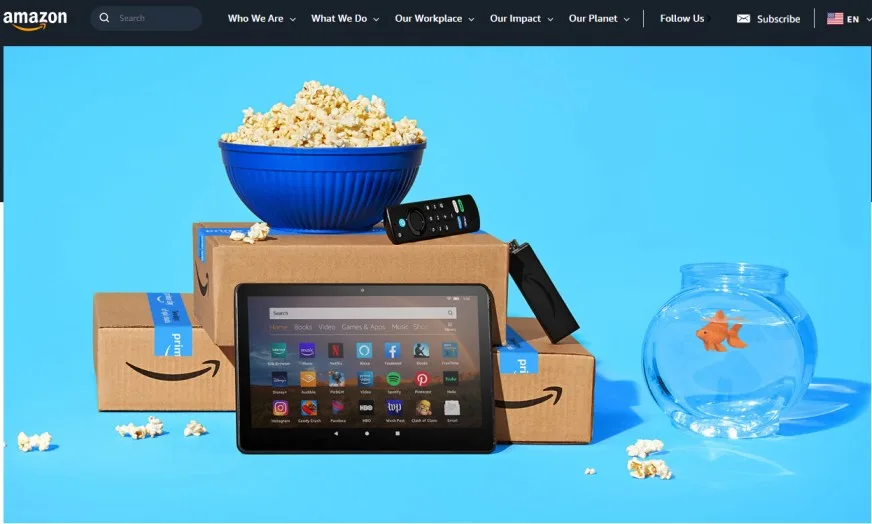
Example 4 – Burberry’s Digital Flagship Stores
The famous luxury fashion brand Burberry also sets high standards in the way it uses multichannel marketing. The manner its retail stores are transformed into digital stores is commendable. This is the reason why customers can enjoy an immersive brand experience both offline and online. The digital screens that are available in-store can be used to browse collections and personalize products effortlessly.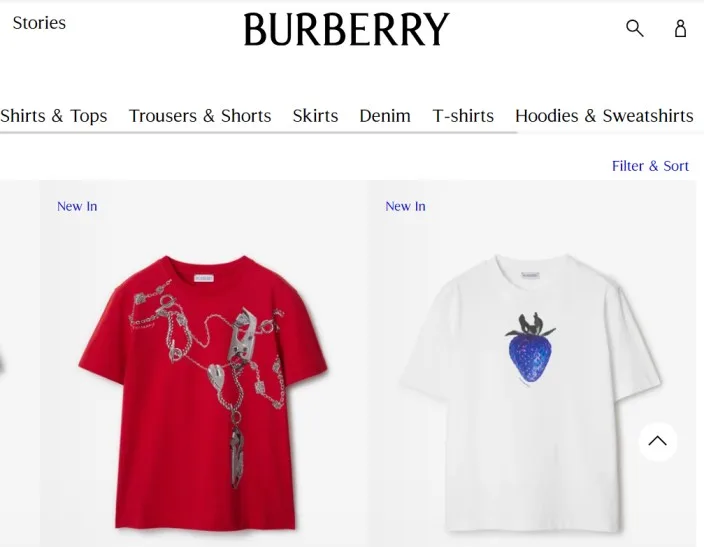
Example 5 – Walmart’s Grocery Pickup and Delivery Service
The global retail giant Walmart always stays one step ahead of emerging trends which it also shows in the way it offers a multichannel shopping experience. It allows customers to book groceries online through the website or mobile app and get them delivered to their doorstep, or have them picked up at a nearby store. Plus, it makes sure that customers can access the same products and prices across channels.


